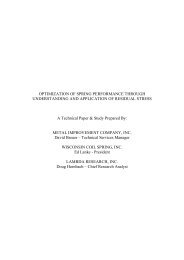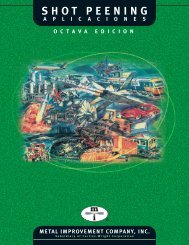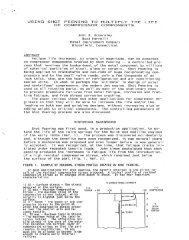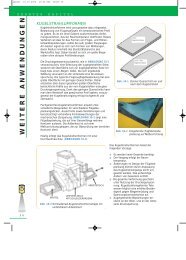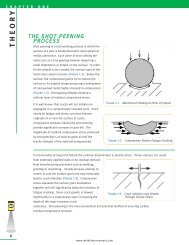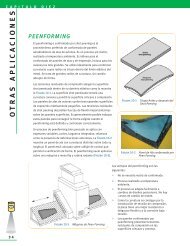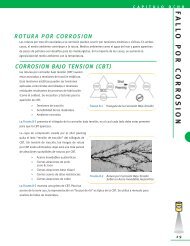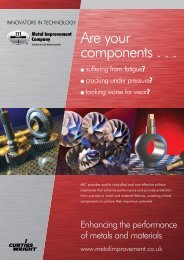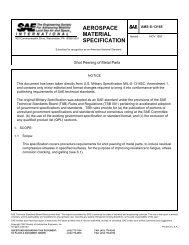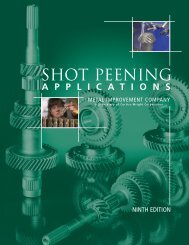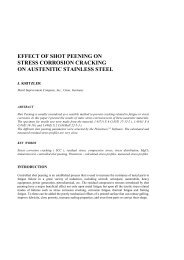shot peening residual stress - Metal Improvement Company
shot peening residual stress - Metal Improvement Company
shot peening residual stress - Metal Improvement Company
You also want an ePaper? Increase the reach of your titles
YUMPU automatically turns print PDFs into web optimized ePapers that Google loves.
C H A P T E R T H R E E<br />
MANUFA CTURING PROCESSES<br />
20<br />
E L E C T R O - C H E M I C A L M A C H I N I N G ( E C M )<br />
Electro-chemical machining is the controlled dissolution of material by contact with a strong chemical<br />
reagent in the presence of an electric current. A reduction in fatigue properties is attributed to surface<br />
softening (the rebinder effect) and surface imperfections left by preferential attack on grain boundaries.<br />
A <strong>shot</strong> <strong>peening</strong> post treatment more than restores fatigue properties as shown in Figure 3-5 [Ref 3.12].<br />
A p p l i c a t i o n C a s e S t u d y<br />
DIAPHRAGM COUPLINGS<br />
<strong>Metal</strong> diaphragm couplings are often used in turbo-machinery applications. These couplings accommodate<br />
system misalignment through flexing. This flexing, or cyclic loading, poses concerns for fatigue failures.<br />
Researchers concluded that the ECM process produces parts that are geometrically near-perfect. However,<br />
they found under scanning electron microscope observation that small cavities sometimes developed on<br />
the surface as a result of ECM. These cavities apparently generated <strong>stress</strong> concentrations that lead to<br />
premature failures. Shot <strong>peening</strong> after ECM was able to overcome this deficiency and has significantly<br />
improved the endurance limit of the diaphragm couplings [Ref 3.13 & 3.14].<br />
REFERENCES:<br />
3.1 Internal <strong>Metal</strong> <strong>Improvement</strong> Co. Memo<br />
3.2 Molzen, Hornbach; Evaluation of Welding Residual Stress Levels Through Shot Peening and Heat Treating, AWS Basic Cracking<br />
Conference; Milwaukee, WI; July 2000<br />
3.3 Haagensen; Prediction of the <strong>Improvement</strong> in Fatigue Life of Welded Joints Due to Grinding, TIG Dressing, Weld Shape Control and Shot<br />
<strong>peening</strong>." The Norwegian Institute of Technology, Trondheim, Norway.<br />
3.4 McCulloch; American Society of Mechanical Engineers, Letter to H. Kolin, May 1975.<br />
3.5 Stern; American Bureau of Shipping, Letter to G. Nachman, July 1983.<br />
3.6 Ubben; American Petroleum Institute, Letter to G. Nachman, February 1967.<br />
3.7 N.A.C.E Standard MR-01-75, Sulfide Stress Cracking Resistant <strong>Metal</strong>lic Material for Oilfield Equipment, National Association of Corrosion Engineers.<br />
3.8 Internal <strong>Metal</strong> <strong>Improvement</strong> Co. Memo<br />
3.9 Molzen, Hornbach; Evaluation of Welding Residual Stress Levels Through Shot Peening and Heat Treating, AWS Basic Cracking Conference;<br />
Milwaukee, WI; July 2000<br />
3.10 <strong>Metal</strong>lurgical Associates, Inc; "Minutes" Vol.5 No.1, Winter 1999; Milwaukee, WI<br />
3.11 Internal <strong>Metal</strong> <strong>Improvement</strong> Co. Memo<br />
3.12 Koster, W.P., Observation on Surface Residual Stress vs. Fatigue Strength, Metcut Research Associates, Inc., Cincinnati, Ohio.<br />
Bulletin 677-1, June 1977<br />
3.13 Calistrat; <strong>Metal</strong> Diaphragm Coupling Performance, Hydrocarbon Processing, March 1977<br />
3.14 Calistrat; <strong>Metal</strong> Diaphragm Coupling Performance, 5th Turbomachinery Symposium, Texas A&M University, October 1976<br />
www.metalimprovement.com



